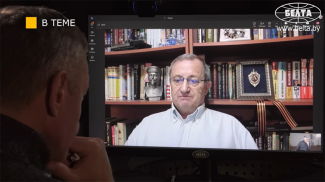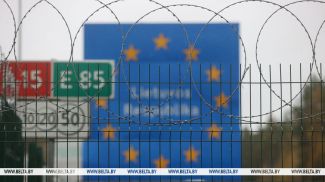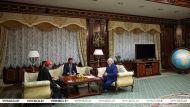MOSCOW, 7 July (BelTA) – The first results of the investigation into the criminal case regarding the genocide of Belarus residents during the Great Patriotic War of 1941-1945 demonstrated that the scale of the tragedy of the Belarusian people is much larger than previous assumptions. Belarus' Prosecutor General Andrei Shved made the statement during a conference of heads of prosecution services of European countries in St Petersburg on 7 July, BelTA has learned. The conference was organized by the Office of the Prosecutor General of Russia in association with the Council of Europe and the International Association of Prosecutors (IAP).
The official said: “The first investigative actions have demonstrated that the scale of the tragedy of the Belarusian nation is considerably larger than it was assumed before.” According to Andrei Shved, one of the places where civilians were murdered in bulk is located in Logoisk District, Minsk Oblast. “In this place alone the number of murdered children, women, and the elderly is much larger than the archives specify,” the prosecutor general said. “The picture it has revealed is frightening due to its inhuman cruelty. The investigators found remains of over 500 people and their personal belongings. Experts concluded that the age of the victims varied from 4 to 70 years. Judging by the direction of the wound tracts one can assume that at the time they were shot, some of the victims were lying face down while others stood on their knees and were shot in the back of the head. Even experienced prosecutors and investigators were impressed by the picture of the babies that mothers hold close to their chest. Witnesses said that the people were led into ravine, forced to lie on top of the murdered, and were shot.”
According to the prosecutor general, as part of the criminal case they are trying to find out how citizens died in concentration camps and death camps. Over 3,000 former prisoners of Nazi camps have been interviewed as part of the criminal case so far. “According to surviving witnesses, people were kept in wooden huts without any hygienic amenities. Many died in winter due to cold weather and diseases. Violence was used to punish even slight violations of the regulations or even without any reason at all. People were beaten with rubber batons and whips with metal ends. They were extremely poorly fed but had to work for 12-14 hours a day. Many former prisoners indicate that the dead were burned in furnaces and the ashes were used as fertilizers in the fields,” Andrei Shved noted.
The criminal case now contains testimony about the atrocities committed in the Ozarichi camp where over 50,000 people were kept. People were herded into a swampy area limited by a barbed wire fence where they stayed in the open air. Approaches to the camp were mined. People were not fed. In order to warm themselves and save themselves and the kids they had to take off clothes from the dead. The testimony is confirmed by many surviving witnesses. Some report that people were deliberately infected with smallpox and typhoid for experiments and in order to slow down the offensive of the Red Army. One of the victims said that adults made huts out of dead bodies and hid children inside in order to warm up the children a bit and save their lives. The Nazi troops would throw cookies to kids only to unleash dogs onto them. The dogs would shred the victims alive. One of the former prisoners said she weighed less than 10kg when she was freed at the age of six. Some witnesses report that before herding people into the camp, Nazi troops forced them to open their mouths. If gold teeth were found, they were extracted with pliers.
Although the Ozarichi camp was a concentration camp in all but name, documents of the Nuremberg Tribunal did not identify it as such. This is why its former prisoners did not receive the relevant compensations. “It is necessary to recognize the obvious status in order to protect rights of the prisoners of death camps and their descendants among other things,” Belarus' prosecutor general stressed.
Andrei Shved continued: “I would like to note that on the whole as a result of the investigation the Prosecutor General's Office is carrying out in addition to tens of thousands of mass population slaughter sites we've found 84 previously unknown sites where according to our estimates up to 3,500 bodies of civilians are buried. This is why the total loss of Belarus' civilian population during the Great Patriotic War or World War Two as it is called now will be much larger than the official figure. We have no district where civilians have not been murdered in bulk. Virtually the entire Belarus is a large communal graveyard.”
The official added that evaluating the real damage and taking measures to get the damage repaired are part of the investigation. Taking measures for compensating the damage caused to natural persons, including camp prisoners and people, who were forced to do compulsory labor outside Belarus, is another aspect of the investigation. Belarus intends to contact international organizations to get the genocide of the Belarusian people recognized at the international level as a result of the investigation.













